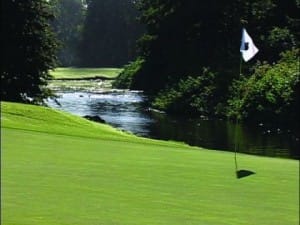Source(s): Gil Landry, PhD., Coordinator- The Center for Urban Agriculture, The University of Georgia.
Proper irrigation is the key to maintaining turfgrasses. Although irrigation may be costly, a green and growing turf improves environmental conditions. The main benefits of a healthy turf include water and wind erosion control. An actively growing turf may have a surface temperature that is 20 degrees F cooler than a dormant turf during the summer.
Turf Drought Maintenance Details
Water use, also called evapotranspiration, is the total amount of water needed for turfgrass growth, plus the quantity evaporated from the soil surface. Turfgrass water use rates depend on soil type, grass species and/or cultivar, management level and atmospheric conditions. Atmospheric water loss increases as temperature and solar radiation increase. Water loss also increases with increasing winds up to four mph, and as humidity decreases. In general, most turfgrasses grown in Georgia use about one inch of water per week to maintain normal growth and color.
Sandy or coarse-textured soils absorb water much faster than clay or fine-textured soils. However, sandy soils retain less water and therefore need water more often than clay soils. Since clay soils absorb water slowly, irrigation rates should be slow and extended over a longer period.
Most turfgrasses grown in Georgia need about one inch of water per week during the summer to remain green and growing. (Table 1). Some turfgrasses, like bermudagrass develop a deep root system to obtain the needed water. But other turfgrasses, like Zoysiagrass, have shallow root system and need weekly irrigation to remain green.
Table 1. provides summer water use rates/drought resistance rankings and irrigation frequency for turfgrass species in Georgia. The water use rate and drought resistance ranking is based on the amount of water used through evapotranspiration and the relative rate the turf begins to show drought stress. The days between irrigations are for mid-summer, high evaporative conditions. The differences between grasses reflect differences in daily evapotranspiration, root depth, viability, and quantity, and turfgrass drought resistance. Under non-irrigated conditions, the relative drought tolerance, or ability to survive without water, becomes more important. Generally, turfgrasses with high water use rates tend to have low drought tolerance.
Table 1. Summer water use rates/drought resistance rankings and irrigation frequency of turfgrasses used in Georgia. |
||
|
COMMON NAME |
WATER USE/DROUGHT RESISTANCE |
DAYS BETWEEN IRRIGATIONS |
|
Bermudagrass |
1 |
14 – 21 |
|
St. Augustinegrass |
2 |
12 – 18 |
|
Centipedegrass |
3 |
8 – 12 |
|
Tall Fescue |
4 |
6-8 |
|
Zoysiagrass |
5 |
5-7 |
During moisture stress periods, raising the mowing height and mowing often enough so that no more than one-third of the leaf tissue is removed can increase turf survival. Raising the mowing height helps the grass maintain a deeper root system which helps it find more water. Irrigate at the first sign of moisture stress. When a turfgrass is under moisture stress it becomes dull and bluish green, the leaf blades fold or roll and footprints remain after walking over the area. If dry conditions continue, the grass wilts. Begin irrigation on that portion of the lawn which first exhibits these signs. Irrigate between sundown and sunrise when the wind and temperatures are lower. Apply enough water to soak the soil to a depth of six to eight inches. This is usually equivalent to about one inch of water or 600 gallons per 1000 square feet but will vary with different soils. A sand would require 0.5 inch of water while a clay would need 1.75 inches to wet the soil to an eight-inch depth. Most sprinklers apply about one-fourth inch of water per hour and thus must be on in one spot for up to four hours to apply one inch of water.
Applying the proper amount of water is one maintenance practice often done wrong. Light, frequent irrigations produce shallow, weak root systems. The shallow root system prevents efficient use of plant nutrients and water in the soil.
If water is being applied faster than the soil can absorb it, either move the sprinkler to a new location or turn it off and allow the water to soak into the soil. To determine the depth of water penetration, use a spade or sharp probe to push into the soil two to four hours after irrigation. The probe will move into the soil very easily where it is moist. The probe becomes harder to push when it hits dry soil.
To test your sprinkler output and application uniformity, place several open-top containers of the same size under the sprinkler. After running the sprinkler for an hour, measure the amount of water in each container. The difference between containers provides an estimate of water distribution and application rate.
Resource(s): Lawns in Georgia
Center Publication Number: 213
- Grasscycling: Feed Your Landscape, Not the Landfill - September 24, 2013
- Fertilizing Lawns - September 24, 2013
- Mowing Lawns - September 24, 2013
